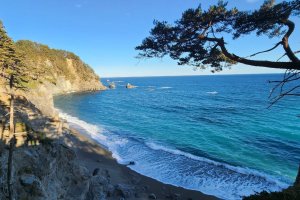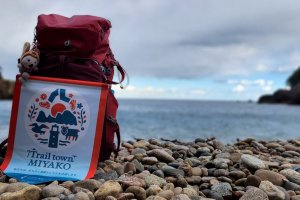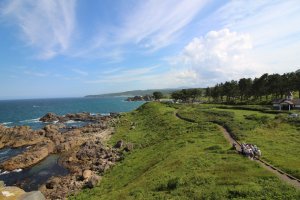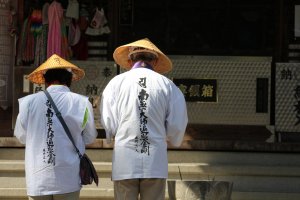As Japan gears up to welcome an influx of visitors for the EXPO 2025 OSAKA, KANSAI, JAPAN, the spotlight shines not only on the host city but also on the diverse regions across the country. While the event promises to showcase innovation, sustainability, and inclusivity under the theme of "Designing Future Society for Our Lives," these core tenets can be experienced and appreciated beyond Osaka itself.
From the picturesque Tohoku coastline to the rich biodiversity of Okinawa, each region of Japan offers its own unique interpretation of the event's key principles. Read on for EXPO 2025 OSAKA, KANSAI, JAPAN-inspired culture and nature trips that will leave an indelible mark long after your journey's are over.
Tohoku
Minimize travel's environmental impact by exploring on foot
Hiking offers a sustainable and immersive way to explore destinations, allowing travelers to connect with nature, culture, and local communities while minimizing their environmental impact. One hiking example in Japan's Tohoku region is the Michinoku Shiokaze Trail, which officially opened in 2019.
The trail spans approximately 700 kilometers along the Pacific coastline of northeastern Japan from Hachinohe City in Aomori to Soma City in Fukushima, showcasing the natural beauty, cultural heritage, and diverse landscapes that Tohoku is known for. It offers hikers an opportunity to explore remote coastal areas, scenic beaches, charming fishing villages, and historic sites, all while promoting sustainable tourism and community development in the region.

Consequently, the Michinoku Shiokaze Trail has played a significant role in the Tohoku region's rebuilding after the Great East Japan earthquake and tsunami of 2011. A section of the trail running through Sanriku Fukko National Park specifically serves to preserve the memory of the earthquake and to convey to future generations the power of nature, the efforts to rebuild, and the lessons learned from the disaster. One of the EXPO 2025 OSAKA, KANSAI, JAPAN sub-themes is "Connecting Lives," and this sharing and preserving of information has a direct correlation with that aspect.
To make hiking the route easier for visitors, the Trail Town MIYAKO project was started in Miyako City, Iwate Prefecture. Various businesses in the area have stickers or flags displayed with the initiative's logo, meaning that they're extra hiker-friendly. For instance, they might have restrooms that hikers can freely utilize, or sell on-the-go food options perfect for trekkers. The Jodogahama Visitor Center in Miyako City serves as a hub for the project, with restrooms, rest areas, trail information, and trail-related goods available for purchase. Not only does this initiative make for a more welcoming environment for travelers, it also helps support regional economies, which is another key goal the EXPO 2025 OSAKA, KANSAI, JAPAN is endeavoring to foster.

If you need any more incentive to visit the Michinoku Shiokaze Trail, it has been recognized on Lonely Planet's "World’s Best New Coastal Trails" list, and by National Geographic on their "Best Trips to Take in 2020" compilation.
Chūbu
Savor a traditional stay in Fukui’s Obama City
The Hokuriku Shinkansen is set to extend to Fukui Prefecture’s Tsuruga Station as of mid-March this year, ushering in a new era of accessibility and connectivity to this part of Japan. The city of Obama is around 45 minutes from Tsuruga Station by car, and is renowned for its historical significance, scenic beauty, and vibrant cultural heritage. Obama is the start of a prominent route for shipping seafood to Kyoto, and as a result, has had an impact on Kyoto’s cuisine. Obama also received some global attention several years ago thanks to sharing its name with a former U.S. president! The area offers visitors a wealth of attractions and experiences to discover, and a great home base for your adventures is at Obama Machiya Stay.

The venue consists of eight renovated folk houses that can be rented out, providing beautiful spaces where visitors can enjoy the best of traditional Japanese life and culture. A visit here can be as relaxed or as involved as you’d like. For instance, there are numerous quality restaurants in the area, but some guests, who like to DIY their meals, opt to buy fresh fish and vegetables at the local market and cook them directly at the inn. The coastal location of Obama makes it a pleasant destination for activities like fishing and beach strolls, and for the history buffs, several temples and shrines have been designated as National Treasures, such as Myotsuji Temple.

Choosing Obama Machiya Stay for your accommodation in the area aligns with the core tenets of the EXPO 2025 OSAKA, KANSAI, JAPAN in several ways. In line with the “Empowering Lives” sub-theme of the event, tourism to Obama creates employment opportunities which contribute to both economic growth and cultural preservation in the region. Eating locally lessens the environmental impact associated with food production and transportation, promoting more sustainable consumption patterns—it also means it’s extra fresh and seasonally appropriate! As a more off-the-beaten-path area of Japan, a visit to Obama also resonates with the “Connecting Lives” sub-theme of the event, helping with regional revitalization and cultural exchange.
Kansai
Soak up Yumura Onsen’s hot spring source to the fullest
Hyogo Prefecture’s Yumura Onsen has a history dating back approximately 1,200 years, and it holds the title of Japan’s hottest onsen with water temperatures sitting around 98 degrees Celsius. Impressively, there are 63 hot spring sources in this relatively small area spanning a radius of about 400 meters, and they provide numerous ways to connect with Japan’s onsen culture.
While the first thoughts of hot springs might immediately be associated with bathing, Yumura Onsen offers more than just a rejuvenating soak—it boasts some incredibly unique culinary experiences as well. Shops around the town sell foodstuffs like eggs, sweet potatoes, and corn, which can be boiled in the onsen’s waters as a method of cooking. If you’re more of a sweet tooth, try submerging a can of condensed milk for a thoroughly delicious DIY caramel-making experience.

Back onto the topic of bathing: the waters at Yumura Onsen are packed with minerals that are said to be excellent for your skin, including sodium-bicarbonate, chloride, and sulfate. Along with their moisturizing properties, the waters are great for hair washing, helping to remove build-up from around the hair follicles, softening the scalp, and even improving blood flow which is said to aid hair growth. There are five different hair-washing shops in the onsen town where you can treat yourself to a memorable shampoo that will leave your scalp feeling squeaky-clean!
So, how is a visit to Yumura Onsen tied to the core tenets of the EXPO 2025 OSAKA, KANSAI, JAPAN? The town’s utilization of geothermal energy aligns closely with the sustainable development goals of the event, showcasing innovative solutions for environmentally friendly practices and sustainable living. It’s not just fun cooking experiences that make the most of Mother Nature’s power here—many of the accommodation options also use hot springs for heating instead of electricity or gas, which is inherently eco-friendly due to its minimal environmental impact and renewable nature. The economic impact of a visit here also provides support and job opportunities for the local community, ensuring that the hot springs can be enjoyed by visitors and residents alike for generations to come.

Shikoku
Take part in a centuries-old pilgrimage route across four prefectures
The Shikoku Pilgrimage, known as the Shikoku Henro in Japanese, is a revered spiritual journey that traces a 1,200-kilometer circuit around the island’s four prefectures of Tokushima, Ehime, Kagawa, and Kochi. Established over 1,200 years ago, the pilgrimage centers around visiting 88 sacred temples associated with the revered Buddhist monk Kobo Daishi (also known as Kukai), who is believed to have founded the Shingon school of Buddhism.

One of the best aspects about the Shikoku Pilgrimage is that it offers an inclusive experience suitable for individuals of all hiking abilities, from beginners to advanced trekkers. For those seeking a more leisurely journey, there is the option to tackle shorter sections of the route or focus on one prefecture only based on personal preferences and physical capabilities. This flexibility makes the trail ideal for those looking to ease into the pilgrimage experience.
Additionally, the Shikoku Pilgrimage doesn’t need to be completed in a sequential order. Participants are free to navigate the route in any direction they choose, allowing for greater freedom in planning and scheduling. While the pilgrimage holds deep religious significance for followers of Buddhism, you certainly don’t need to approach the trek from a religious standpoint—for many, it’s simply enjoyed as a means of personal reflection and self-discovery.

Interest in the Shikoku Pilgrimage from outside Japan has been growing in recent years, with features in publications like the New York Times shining a light on what they refer to as a travel experience with "breathtaking views and sublime lessons on Japanese cultural heritage." The increase in visitor numbers continues to support local economies, especially in areas dealing with the challenges of aging populations and urban migration. It also serves as a means of cultural exchange—just like the EXPO 2025 OSAKA, KANSAI, JAPAN aims to do—by connecting pilgrims with the communities they pass through.
Okinawa
Discover the island's biodiversity and the people who coexist with it
Japan’s southernmost prefecture of Okinawa is not only renowned for its vibrant culture and tropical scenery, but also for its remarkable biodiversity. From lush mangrove forests to coral reefs teeming with marine life, the region’s ecosystems are both environmentally significant and culturally cherished.

One place to learn about the island’s biodiversity is at Nanmeishinshitsu, an accommodation facility in Kunigami Village on Okinawa’s northern coast. This part of the prefecture has been designated as a World Natural Heritage Site, and Kunigami Village itself has over 400 years of history.
A stay here means you’re escorted by your own sherpa, and they are described as “pilots who support your stay with local knowledge and networks.” They’re able to help visitors open their eyes to aspects of this area that may have otherwise passed them by, providing a more in-depth travel experience. Your sherpa can help you connect with Okinawa in various ways, from leading guided nature walks to bringing you local meat and vegetables to grill on a barbecue for dinner. If dining out is more your style, your sherpa can even make reservations at popular local restaurants for you. For the hands-on travelers, activities like cooking classes or sailing experiences can be arranged subject to seasonality.

The unique accommodation experience at Nanmeishinshitsu connects with the EXPO 2025 OSAKA, KANSAI, JAPAN principles in a number of ways. Learning about Okinawa’s biodiversity directly from a local sherpa is in line with the event’s sub-theme of “Saving Lives,” which aims to address challenges that threaten people and life on the planet. The “Empowering Lives” sub-theme looks at food culture and smart agriculture, which is represented in the focus on local eats and cooking classes featuring locally-sourced ingredients. The “Connecting Lives” sub-theme also resonates here. The sharing of information between sherpas and guests is a unique way of preserving traditions and customs for future generations to learn from.
Looking for more?
Explore our additional article here for some activity-based adventures inspired by the EXPO 2025 OSAKA, KANSAI, JAPAN principles, and check out the Expo 2025 Official Experiential Travel Guides website.




























